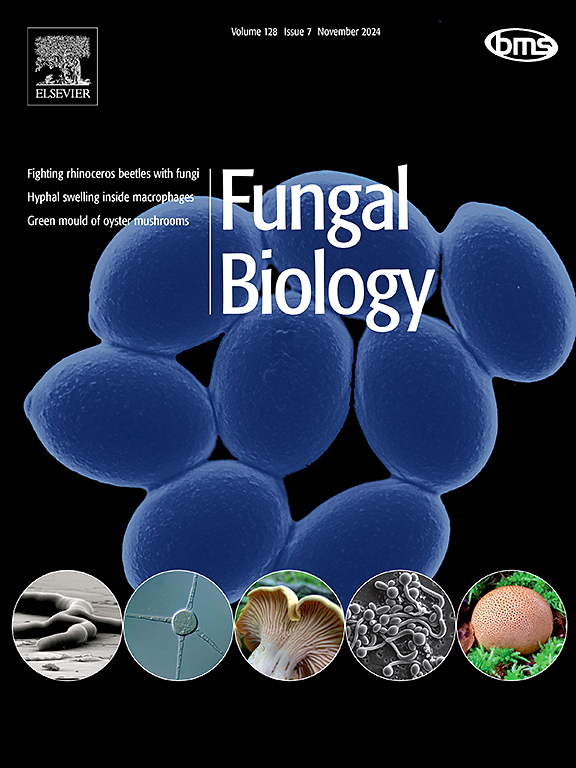挪威震旦藻类相关真菌的多样性以及次生代谢物在寄主特异性中的作用
IF 3
3区 生物学
Q2 MYCOLOGY
引用次数: 0
摘要
地衣寄生银耳真菌的多样性和寄主关系仍未得到充分研究,部分原因是它们的无症状酵母期。本研究采用ITS2元条形码技术研究了在挪威收集的13种百日枯地衣中这些真菌的多样性和定植模式。我们发现了很高的患病率,银耳真菌存在于57%的检查标本中,代表了所包括的13个物种中的12个,其中10个以前未被认为是宿主。我们的研究结果表明,这些真菌的酵母菌期存在广泛的宿主范围,尽管五种最常见的otu在不同宿主物种中的出现是非随机的。此外,负二项一般线性模型表明,银耳真菌的存在与百日咳寄主体内特定次级代谢物(如硫代苯胺酸、富马原三羧酸和旋磷酸)的出现呈负相关。这些结果突出了以前未记载的银耳真菌的遗传多样性,并表明宿主化学型显著影响定植模式。我们的研究结果表明,无症状定植的频率比以前报道的要高,强调需要进一步研究它们的生态作用和相互作用。本文章由计算机程序翻译,如有差异,请以英文原文为准。
Diversity of tremellalean Pertusaria-associated fungi in Norway and the role of secondary metabolites in host specificity
The diversity and host relationships of lichen-inhabiting tremellalean fungi remain understudied, partly due to their asymptomatic yeast phase. This study employs ITS2 metabarcoding to investigate the diversity and colonization patterns of these fungi within 13 Pertusaria lichen species collected in Norway. We discovered a high prevalence, with tremellalean fungi present in 57 % of the examined specimens, representing 12 of the 13 species included, 10 of which were not previously recognized as hosts. Our findings suggest a broad host range for the presumed yeast phase of these fungi, though occurrences of the five most frequent OTUs appeared non-random across different host species. Additionally, negative-binomial general linear models indicated a negative correlation between the presence of tremellalean fungi and the occurrence of specific secondary metabolites, such as thiophaninic acid, fumarprotocetraric acid, and gyrophoric acid, in Pertusaria hosts. These results highlight previously undocumented genetic diversity within tremellalean fungi and suggest that host chemotype significantly influences colonization patterns. Our findings demonstrate a higher frequency of asymptomatic colonization than previously reported, emphasizing the need for further research into their ecological roles and interactions.
求助全文
通过发布文献求助,成功后即可免费获取论文全文。
去求助
来源期刊

Fungal biology
MYCOLOGY-
CiteScore
5.80
自引率
4.00%
发文量
80
审稿时长
49 days
期刊介绍:
Fungal Biology publishes original contributions in all fields of basic and applied research involving fungi and fungus-like organisms (including oomycetes and slime moulds). Areas of investigation include biodeterioration, biotechnology, cell and developmental biology, ecology, evolution, genetics, geomycology, medical mycology, mutualistic interactions (including lichens and mycorrhizas), physiology, plant pathology, secondary metabolites, and taxonomy and systematics. Submissions on experimental methods are also welcomed. Priority is given to contributions likely to be of interest to a wide international audience.
 求助内容:
求助内容: 应助结果提醒方式:
应助结果提醒方式:


